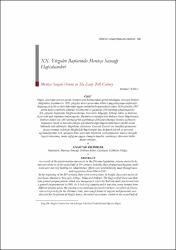| dc.contributor.author | Temel, Mehmet | |
| dc.date.accessioned | 2020-11-20T17:35:02Z | |
| dc.date.available | 2020-11-20T17:35:02Z | |
| dc.date.issued | 2009 | |
| dc.identifier.issn | 1300-5766 | |
| dc.identifier.uri | https://app.trdizin.gov.tr//makale/T1RZek5qZzQ | |
| dc.identifier.uri | https://hdl.handle.net/20.500.12809/8137 | |
| dc.description.abstract | Hapis, ceza infaz sistemi olarak Osmanlı ceza hukukundaki yerini batılılaşma süreciyle birlikte aldığından, hapishaneler XIX. yüzyılın ikinci yarısından itibaren yaygınlaşmaya başlamıştır. Başlangıçta fiziki ve sıhhi bakımdan uygun mekânlarda açılmadıklarından 1856 yılından 1917 yılına kadar aralıklarla çıkarılan nizamname ve yasalarla ıslah edilmeye çalışılmışlardır. XX. yüzyılın başlarında Muğla merkeziyle Marmaris, Köyceğiz, Fethiye, Milas ve Bodrum ilçelerinde yedi hapishane bulunuyordu. Bunların en büyüğü olan Bodrum Genel Hapishanesi, Bodrum Kalesi’nin 1895 yılında genel hapishaneye dönüştürülmesiyle hizmete açılmıştır. Kapasitesi büyük ve havadar olduğu için ülkenin diğer hapishanelerinden sürekli olarak hükümlü sevk edilmiştir. Hapishane ıslahatının Osmanlı Devleti’nin öncelikli gündemini oluşturmaması nedeniyle Muğla’daki hapishaneler için de yeterli ödenek ve personel ayrılmadığından XIX. yüzyılın ikinci yarısında başlatılan ıslah çalışmaları istenen düzeyde başarılı olamamış, insan sağlığına uygun olmayan koşullar cumhuriyet dönemine kadar devam etmiştir. | en_US |
| dc.description.abstract | As a result of the westernization movement in the Ottoman legislation, prisons started to be more prevalent as of the second half of 19th century. Initially, their physical and hygiene conditions were not very healthy but rehabilitation efforts were intermittently made through laws and regulations from 1856 to 1917. At the beginning of the 20th century, there were seven prisons in Muğla city center and in its provinces; Marmaris, Kö yceğiz, Fethiye, Milas and Bodrum. The biggest of all these was Bodrum general-purpose prison, which was inaugurated, when the Bodrum castle was turned into a general-purposeprison in 1895. As it had a big capacity and it was airy, many inmates from different prisons across the country were continuously transferred here. As reform of prisons was not a priority for the Ottoman State, not enough financial support and personnel were allocated for the prisons of Muğla; hence, the reform movements started in the second half of the 19th century were not much of a success. Therefore, prison conditions that were not suitable for human health persisted until Republic era. | en_US |
| dc.item-language.iso | tur | en_US |
| dc.item-rights | info:eu-repo/semantics/openAccess | en_US |
| dc.subject | Tarih | en_US |
| dc.title | XX. yüzyılın başlarında Menteşe Sancagı hapishaneleri | en_US |
| dc.item-title.alternative | Menteşe Sanjak prisons in the early 20th century | en_US |
| dc.item-type | article | en_US |
| dc.contributor.department | MÜ, Edebiyat Fakültesi, Tarih Bölümü | en_US |
| dc.contributor.institutionauthor | Temel, Mehmet | |
| dc.identifier.volume | 0 | en_US |
| dc.identifier.issue | 26 | en_US |
| dc.identifier.startpage | 109 | en_US |
| dc.identifier.endpage | 135 | en_US |
| dc.relation.journal | Türkiyat Araştırmaları Dergisi | en_US |
| dc.relation.publicationcategory | Makale - Ulusal Hakemli Dergi - Kurum Öğretim Eleman | en_US |


















